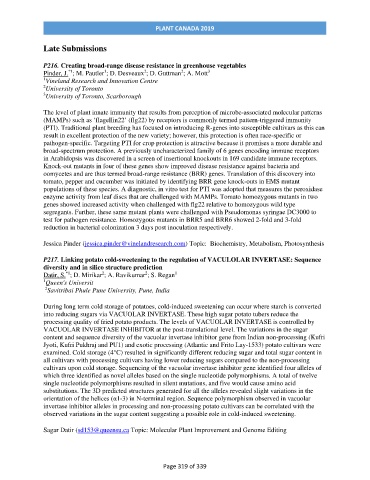Page 321 - PC2019 Program & Proceedings
P. 321
PLANT CANADA 2019
Late Submissions
P216. Creating broad-range disease resistance in greenhouse vegetables
*1
2
1
3
Pinder, J. ; M. Pautler ; D. Desveaux ; D. Guttman ; A. Mott
2
1 Vineland Research and Innovation Centre
2 University of Toronto
3 University of Toronto, Scarborough
The level of plant innate immunity that results from perception of microbe-associated molecular patterns
(MAMPs) such as ‘flagellin22’ (flg22) by receptors is commonly termed pattern-triggered immunity
(PTI). Traditional plant breeding has focused on introducing R-genes into susceptible cultivars as this can
result in excellent protection of the new variety; however, this protection is often race-specific or
pathogen-specific. Targeting PTI for crop protection is attractive because it promises a more durable and
broad-spectrum protection. A previously uncharacterized family of 6 genes encoding immune receptors
in Arabidopsis was discovered in a screen of insertional knockouts in 169 candidate immune receptors.
Knock-out mutants in four of these genes show improved disease resistance against bacteria and
oomycetes and are thus termed broad-range resistance (BRR) genes. Translation of this discovery into
tomato, pepper and cucumber was initiated by identifying BRR gene knock-outs in EMS mutant
populations of these species. A diagnostic, in vitro test for PTI was adopted that measures the peroxidase
enzyme activity from leaf discs that are challenged with MAMPs. Tomato homozygous mutants in two
genes showed increased activity when challenged with flg22 relative to homozygous wild type
segregants. Further, these same mutant plants were challenged with Pseudomonas syringae DC3000 to
test for pathogen resistance. Homozygous mutants in BRR5 and BRR6 showed 2-fold and 3-fold
reduction in bacterial colonization 3 days post inoculation respectively.
Jessica Pinder (jessica.pinder@vinelandresearch.com) Topic: Biochemistry, Metabolism, Photosynthesis
P217. Linking potato cold-sweetening to the regulation of VACULOLAR INVERTASE: Sequence
diversity and in silico structure prediction
2
2
1
*1
Datir, S. ; D. Mirikar ; A. Ravikumar ; S. Regan
1 Queen's Universit
2
Savitribai Phule Pune University, Pune, India
During long term cold storage of potatoes, cold-induced sweetening can occur where starch is converted
into reducing sugars via VACUOLAR INVERTASE. These high sugar potato tubers reduce the
processing quality of fried potato products. The levels of VACUOLAR INVERTASE is controlled by
VACUOLAR INVERTASE INHIBITOR at the post-translational level. The variations in the sugar
content and sequence diversity of the vacuolar invertase inhibitor gene from Indian non-processing (Kufri
Jyoti, Kufri Pukhraj and PU1) and exotic processing (Atlantic and Frito Lay-1533) potato cultivars were
examined. Cold storage (4°C) resulted in significantly different reducing sugar and total sugar content in
all cultivars with processing cultivars having lower reducing sugars compared to the non-processing
cultivars upon cold storage. Sequencing of the vacuolar invertase inhibitor gene identified four alleles of
which three identified as novel alleles based on the single nucleotide polymorphisms. A total of twelve
single nucleotide polymorphisms resulted in silent mutations, and five would cause amino acid
substitutions. The 3D predicted structures generated for all the alleles revealed slight variations in the
orientation of the helices (α1-3) in N-terminal region. Sequence polymorphism observed in vacuolar
invertase inhibitor alleles in processing and non-processing potato cultivars can be correlated with the
observed variations in the sugar content suggesting a possible role in cold-induced sweetening.
Sagar Datir (sd153@queensu.ca Topic: Molecular Plant Improvement and Genome Editing
Page 319 of 339

